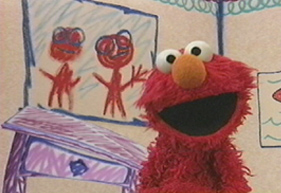Siggraph 2001: Conference Abstracts and Applications (Sketches &
Applications p.178)
Elmo's World: Digital Puppetry on
Sesame Street
Emre Yilmaz
www.digitalpuppetry.com
PO Box 460022, San Francisco, CA 94146-0022
emre at digitalpuppetry dot com
Collaborators:
Sesame Workshop
Dave Satin, Les Rudner
Eric Gregory (Protozoa)

Recently, we received an unusual but exciting request: to make a drawer
bark like a dog, to make a TV set cry like a baby, and to do it all
live on set with Elmo. Elmo's World is a daily 15-minute
show-within-a-show on "Sesame Street." In his imaginary world, the
popular red Muppet monster learns about a new concept each day (for
instance, dogs, babies, or bananas). Among Elmo's friends in this world
are four pieces of furniture. We bring these furniture creatures to
life using real-time computer animation, or "digital puppetry."
Specifically, we use an experimental motion-capture method.
The Need
As we worked live on set, our furniture characters were improvising
their performances alongside the real puppets. Sesame Street Executive
Producer Arlene Sherman further requested that the furniture not only
be able to do basic functions, like opening and closing a drawer, but
also act like living, thinking beings with personalities and
quirks. The idea is that Elmo has drawn these creatures, but they
have come to life, and they are not always cooperative. The window
shade may be more interested in tickling Elmo than in opening up for
him. The TV set may try to come to Elmo, but waddle and fall over like
a baby unsuccessfully taking its first steps.
Digital Puppetry
The models were relatively easy to make, but finding a suitable
performance method was difficult. We decided to try an experimental
method for puppeteering the characters, using foam rubber blocks
outfitted with magnetic motion- capture sensors. If a puppeteer twisted
one foam rubber block, the table would twist. If they hopped the foam
up and down across the floor, the door character would hop up and down
across Elmo's floor. We can't use the captured motion quite straight;
we do a lot of real-time modifications on the data to fit the
character’s proportions and position in the room. In addition to the
foam rubber blocks and motion sensors, we provided foot pedals,
joysticks, and sliders so the puppeteers could augment the
performances. For instance, one foot pedal opened and closed the
drawer. That way, one puppeteer could both make the drawer walk
around and make its "mouth" open and close.
We felt this would be a very puppeteer- friendly approach, because it
allows intuitive control and a great range of motion. The puppeteers
could actually grab and manipulate the drawer, the TV set, and the door
directly, just as if they were real puppets, watching the live video
feedback to see how their characters were moving.
Production
During taping, the digital puppeteers watch their characters
interacting live onscreen with Elmo. The camera sees Elmo in front of
the real set, and a quick live composite allows the puppeteers and the
director to see how the furniture will look in this shot. What they are
seeing is very close to the final result. The puppeteering performance
data are captured from the foam rubber blocks and other devices for
later playback. Keeping the motion data, and waiting till
post-production to commit it to videotape, allowed fixes as necessary.
Three of Sesame Street's regular Muppet performers enact the puppet
furniture. The real Muppet performers are highly accomplished at
bringing character to inanimate objects. They are also very experienced
at interacting with Elmo! Many of the best interactions are improvised
live on set. We wanted to enable them to bring all their experience and
talent, including improvisation, to the digital characters as
seamlessly as possible.
Note: We originated this project at Protozoa (r.i.p.) Protozoa
also created the ALIVE custom software we used on the project.
Elmo and other characters are Copyright © Henson Associates and
CTW (Childrens' Television Workshop).
